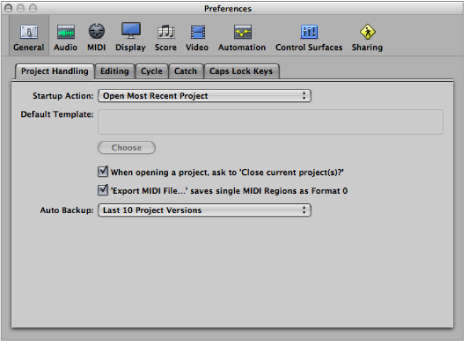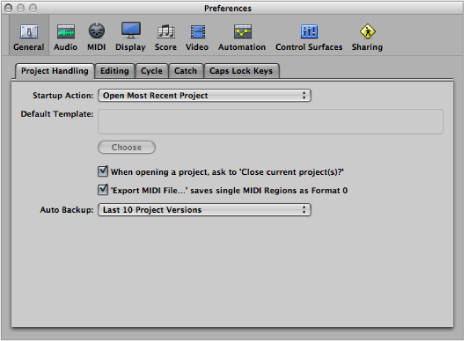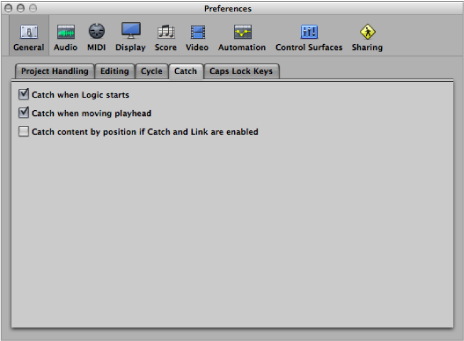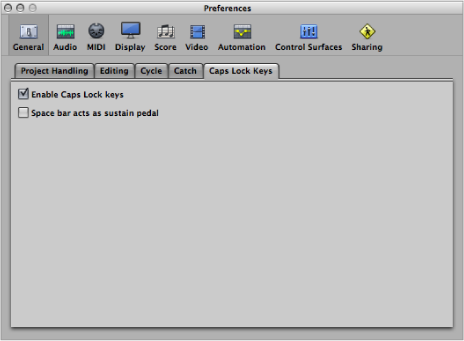General Preferences in Logic Pro
General preferences consist of the following tabs: Project Handling, Editing, Cycle, Catch, and Caps Lock Keys.

Choose Logic Pro > Preferences > General (or use the Open General Preferences key command).
Click the Preferences button in the Arrange toolbar, then choose General from the pop-up menu.
General Project Handling Preferences
Project Handling preferences determine how Logic Pro handles projects.

- Startup Action pop-up menu: The Startup Action pop-up menu allows you to choose from a number of project options that happen automatically when Logic Pro is opened. You can choose from:
- Do Nothing: Nothing happens when Logic Pro is opened; you need to create a new project, or open an existing project or template.
- Open Most Recent Project: Opens the project you were working on when you last closed Logic Pro.
- Open Existing Project: Shows the Open dialog, allowing you to browse for an existing project.
- Create New Project from Template: Opens the Templates dialog.
- Create New Empty Project: Loads an empty project and opens the New Tracks dialog, allowing you to specify the number and type of new tracks to be created.
- Create New Project using Default Template: Opens the default template and the Save As dialog, allowing you to name and save your project.
- Ask: Opens a Startup dialog, offering each of the above options.
- “When opening a project, ask to ‘Close current project(s)?’” checkbox: Whenever you load a new project before closing the old one, a dialog appears, asking whether or not the current project should be closed. If this option is left unselected, you are not asked the question, and the current project remains open.
- “‘Export MIDI File’ saves single MIDI Regions as Format 0” checkbox: If only one MIDI region is selected when you use the File > Export > Selection as MIDI File command, the contents of the region are saved in MIDI file format 0. This file format is guaranteed to be compatible with every MIDI file player.
General Editing Preferences
The Editing pane contains the following preferences:

- Right Mouse Button pop-up menu: Determines the right mouse button behavior (assuming you have a suitable mouse).
- Is Assignable to a Tool: A third Tool menu (Right-click Tool menu) appears to the right of the Left-click and Command-click Tool menus. Choose the appropriate menu item to assign the tool, which is available when the right mouse button is pressed while editing.
- Opens Tool Menu: Opens the Tool menu with the Pointer tool (and not the currently selected tool) located under the mouse pointer. Simply choose the tool you want by clicking it. When the Tool menu is open, you can also use the key shown next to a tool to select it.
- Opens Shortcut Menu: Displays a menu that offers a number of area-specific selection and editing commands.
- Opens Tool and Shortcut Menu: Opens the Tool menu as well as the shortcut menu, which offers a number of area-specific selection and editing commands.
- Pointer Tool in Arrange Provides: Fade Tool Click Zones checkbox: When this checkbox is selected, placing the mouse pointer over the upper-left and upper-right edges of a region activates the Fade cursor and behavior. The Loop cursor and behavior can still be accessed in these click zones by holding down the Option key.
- Limit Dragging to One Direction In: Piano Roll and Score checkbox: When this checkbox is selected, you can only move notes in one direction (horizontally or vertically), per operation, when editing in the Piano Roll or Score Editor. This means that a note may be either transposed, or moved in time, but not both at once. This prevents accidental alterations of one or the other parameter.
- “’Living Groove’ connection” checkbox: Select this checkbox to make sure that editing an original region also alters any quantization template derived from that region. Leave the checkbox unselected to make sure that the groove template remains as created. This allows you to edit the region without affecting the quantization template.
- “SmartLoop handling of Scissors and ‘Split by Playhead’” checkbox: This option determines how Logic Pro handles the cutting of looped regions.
If you select this option, you can cut the looped area of regions (using the Scissors or Marquee tool, or Split by Playhead command). Logic Pro automatically creates regions after—and, if necessary, before—the cut, ensuring that these areas remain identical. This allows you to split looped regions without altering playback in the looped area.
If the “SmartLoop handling of Scissor and Split by playhead” option is not selected, you cannot cut looped areas. Cutting the looped region itself deactivates the Loop parameter in the Region Parameter box.
- “Select Regions on Track selection” checkbox: When this checkbox is selected, selecting a track automatically selects all regions on the track lane (or regions within the cycle or autopunch area if Cycle or Autopunch is enabled). Turn off the preference if you don’t want regions to be automatically selected when the track header is chosen. When the preference is disabled:
Option-clicking the track header or associated channel strip continues to select the track and all associated regions.
Option-Shift-clicking adds the selected track’s regions to the current selection.
General Cycle Preferences
The Cycle pane contains the following preferences:

- Cycle Pre-Processing pop-up menu: In order to ensure a smooth cycle jump (from the end point of a cycle back to the start point of a cycle), the cycle jump is processed slightly before its actual position. This preference allows you to change the pre-processing time. A value of 1/96 is chosen by default, which should be suitable for most uses.
- Smooth Cycle Algorithm checkbox: This option improves the timing of cycle jumps, making it easier to set the length of sample loops while in Cycle mode—although this is somewhat mitigated through the use of Apple Loops. If your computer has a very slow processor, this setting reduces the processing requirements for graphics operations. In general, you want to keep this on whenever possible, especially if you’re working in a style that involves frequent cycling of musical sections. If you find that your cycled sections are not as smooth as you’d like (assuming that your loops are actually perfect), you might achieve better results by deselecting this parameter.
General Catch Preferences
The Catch pane contains the following preferences:

- “Catch content by position if Catch and Link are enabled” checkbox: If the Catch and Link buttons are active (Content Catch mode), the contents of the region at the current playhead position are shown. If this option is turned off, the window view still follows the playhead position within the displayed region, but does not update to show the contents of subsequent regions as the playhead passes them (in playback or record mode).
